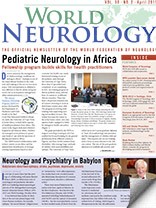Infection is an independent risk factor for both ischemic and hemorrhagic stroke
By Jerome H. Chin, MD, PhD, MPH

Jerome H. Chin, MD, PhD, MPH
Stroke is the third-leading cause of premature death globally as measured in years of life lost1. Demographic and epidemiologic changes, including population growth and aging, urbanization and unhealthy diets are driving a rise in the incidence of stroke in low- and middle-income countries (LMIC)2. Due to inadequate primary health care services to screen for and treat the most common stroke risk factors, particularly hypertension and diabetes, the age-standardized incidence rates of stroke in LMIC exceed those in high-income countries2. In addition, strokes due to atrial fibrillation and rheumatic heart disease contribute a significant share of the stroke burden in LMIC as a result of both diagnostic and therapeutic resource limitations for these conditions.

Figure. HIV-associated stroke: (a) middle cerebral artery infarct; 25-year-old HIV-infected male, CD4+ cell count = 42 cells/mm3; (b) bilateral basal ganglia infarcts; 25-year-old HIV-infected female, unknown CD4+ cell count.
HIV infection has recently emerged as an independent risk factor for both ischemic and hemorrhagic stroke3-8. Two cohort studies conducted in the United States reported an elevated risk of ischemic stroke in HIV-infected individuals compared to non-HIV-infected individuals4,5. Lower CD4+ cell counts or higher HIV RNA levels were associated with an increased risk of stroke. Cohort studies from Canada and the United States have reported an association of HIV infection with an increased risk of intracerebral hemorrhage6,7. A community-based case-control study performed in Tanzania found HIV infection to be an independent risk factor for stroke (ischemic and hemorrhagic combined) with an adjusted odds ratio of 5·618. Only 40 percent of the 200 stroke cases had a CT scan. The pathogenic mechanisms responsible for the increased risk of stroke associated with HIV infection are multiple and may include chronic inflammation and immune activation leading to endothelial dysfunction and subsequent vasculopathy3,9. Both small-vessel (e.g. lacunar) and large-vessel strokes are observed in HIV-infected individuals (figure) in addition to intracerebral hemorrhages.
Thirty-five million people are living with HIV worldwide10. The population-attributable risk of stroke due to HIV infection will depend on the prevalence of HIV infection in a particular region or country. Given the higher prevalence of HIV infection in sub-Saharan Africa compared to other regions, a substantial number of incident strokes in sub-Saharan Africa may be the result of HIV infection. However, reliable figures for stroke incidence, mortality and comorbidities are difficult to obtain in most countries of sub-Saharan Africa due to inadequate stroke surveillance and vital registration data. The above-mentioned epidemiologic studies provide support for the inclusion of HIV antibody testing in the diagnostic evaluation of patients with acute stroke in all regions of the world. Furthermore, stroke prevention should now be considered another potential benefit of the early initiation of antiretroviral therapy in HIV-infected individuals through both a reduction in HIV-associated vasculopathy as well as through the prevention of HIV transmission to their uninfected partners.
References
- GBD 2013 Mortality and Causes of Death Collaborators. Global, regional, and national age–sex specific all-cause and cause-specific mortality for 240 causes of death, 1990–2013: a systematic analysis for the Global Burden of Disease Study 2013. Lancet. 2015;385:117-171.
- Krishnamurthi RV, Feigin VL, Forouzanfar MH, et al. Global and regional burden of first-ever ischaemic and haemorrhagic stroke during 1990–2010: findings from the Global Burden of Disease Study 2010. Lancet Glob Health. 2013;1(5):e259-e281. doi:10.1016/S2214-109X(13)70089-5.
- Cole JW, Chin JH. HIV infection: a new risk factor for intracerebral hemorrhage? Neurology. 2014;83:1690-1.
- Marcus JL, Leyden WA, Chao CR, et al. HIV
infection and incidence of ischemic stroke, AIDS. 2014;28:1911–1919. - Chow FC, Regan S, Feske S, Meigs JB, Grinspoon SK, Triant VA. Comparison of ischemic stroke incidence in HIV-infected and non-HIV-infected patients in a U.S. health care system. J Acquir Immune Defic Syndr. 2012;60:351-358.
- Chow FC, He WS, Bacchetti P, et al. Elevated rates of intracerebral hemorrhage in individuals from a U.S. clinical care HIV cohort. Neurology. 2014;83:1705–1711.
- Durand M, Sheehy O, Baril JG, LeLorier J, Tremblay CL. Risk of spontaneous intracranial hemorrhage in HIV infected individuals: a population-based cohort study. J Stroke Cerebrovasc Dis. 2013;22:e34–e41.
- Walker RW, Jusabani A, Aris E, et al. Stroke risk factors in an incident population in urban and rural Tanzania: a prospective, community-based, case-control study. Lancet Glob Health. 2013;1:e282–e288.
- Benjamin LA, Bryer A, Emsley HCA, Khoo S, Solomon T, Connor MD. HIV infection and stroke: current perspectives and future directions. Lancet Neurol. 2012;11:878–90.
- UNAIDS, The Gap Report, available at: http://www.unaids.org/en/resources/campaigns/2014/2014gapreport/gapreport/ Accessed January 25, 2015.
